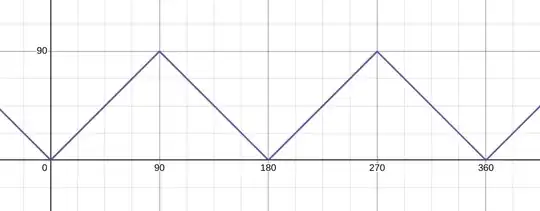I am trying to short-cut the following with modulo, but it is not working for 90 and 270 degrees. What is the correct short-cut?
\begin{equation} \delta'= \begin{cases} \delta & \text{if } 0 \le \delta \le 90 \\\\ 180 - \delta & \text{if } 90 \lt \delta \le 180 \\\\ \delta - 180 & \text{if } 180 \lt \delta \le 270 \\\\ 360 - \delta & \text{if } 270 \lt \delta \le 360 \\\\ \end{cases} \end{equation}
Trying: \delta % 90
| delta | expected delta-prime | calculated | equal? |
|---|---|---|---|
| 0 | 0 | 0 | TRUE |
| 30 | 30 | 30 | TRUE |
| 45 | 45 | 45 | TRUE |
| 60 | 60 | 60 | TRUE |
| 90 | 90 | 0 | FALSE |
| 105 | 75 | 75 | TRUE |
| 130 | 50 | 50 | TRUE |
| 150 | 30 | 30 | TRUE |
| 180 | 0 | 0 | TRUE |
| 200 | 20 | 20 | TRUE |
| 220 | 40 | 40 | TRUE |
| 230 | 50 | 50 | TRUE |
| 270 | 90 | 0 | FALSE |
| 280 | 80 | 80 | TRUE |
| 300 | 60 | 60 | TRUE |
| 320 | 40 | 40 | TRUE |
| 330 | 30 | 30 | TRUE |
| 350 | 10 | 10 | TRUE |
| 360 | 0 | 0 | TRUE |
